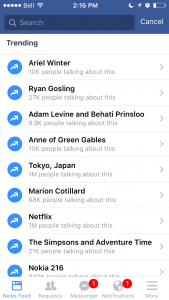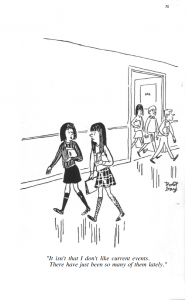Upon reading more about what the medium and the message really mean, there have been a few ways that I can now see the affect on my own life. I think about how what a huge effect the medium has on my interpretation of messages, including those on social media, advertisements, and personal notes. I find this particularly interesting in the context of growing up in a world saturated with hundreds of ways to communicate the same thing. Now, having read and experienced “The Medium is the Massage” (McLuhan et al.,1967) I have developed a more critical perspective of my own understanding of how I perceive messages presented around me. In this blog post, I am going to discuss how this work gave me insight into how I consume media. As an extension of the discussion from last week’s class, I also wanted to further explore how the medium of Facebook’s trending news feed affects the public consumption of news in relation to McLuhan’s ideas.
Instead of media being a passive component of the message, I now view it as one of the most important parts of how that message is being communicated. On the same note, I’ve started to reflect more on how media, unbeknownst to myself, has shaped the way that I think and portray my own ideas. For example, in the context of using today’s social media: when chatting with a friend, which platform do I choose to display my message? I could send a photo via Snapchat to as many friends as I want, or share the same photo on Facebook, Instagram, or Twitter. Each platform is used in different scenarios and represents a way to present my idea differently or how private I want the message to be. Yet, with immersion to these platforms on such a regular basis, it becomes second nature to know which platform makes sense. I know before I even post that photo that the way I choose to present it communicates a specific type of message, depending on the setting I select. Thus, this in depth knowledge that has created an instinct on how to use social media, speaks a lot to the total immersion that McLuhan believes technology will have on our lives.
McLuhan suggests that the way that we – as heavy users of technology – process information is also beginning to change dramatically. Because of the mass amount of information that we have access to within a few taps, the sheer amount of information has become overwhelming. During a classmate’s presentation last week, an action she encouraged the class to take had an effect on me. She suggested that everyone take out their phones and check the trending hashtags on Twitter. At the time, I hadn’t yet downloaded the app (I have now updated it with links to this blog and will continue to do so in the future), I instead looked at the trending tags on my Facebook. While what I found wasn’t necessarily surprising, I was looking at it with a more critical eye this time. On my iPhone Facebook mobile, the formatting for trending news topics looks like this:

The top trending topics – in the case above, mostly related to celebrity news – are chosen according to algorithms. However, Facebook was under fire earlier this year according to accounts that workers curate certain topics, excluding right wing stories and opinions. More about that topic in the video here.
Though Facebook has taken moves to be more transparent about how these stories are chosen, this still urges me to wonder how much of the news is broadcast – and how much is left behind. While we may believe that the media we regularly consume is neutral – it’s unnerving to come to the realization that it is highly curated. Even when (what I would consider) important news stories such as natural disasters or political movements come to the forefront, and are featured on the general trending topics feed, they are discreetly placed among other topics. On the day of our discussion, I found the contents of the newsfeed especially unsettling. The topics included:
- Amal Clooney + ISIS
- Pokémon GO
- US Syrian Airstrike
- Netflix
The topics discussing death and politics, that have a significant, and often deadly, impact on thousands, are sandwiched in with media stories such as updates on Pokémon GO and a few new series posted on Netflix. As already discussed, this medium is already seemingly impartial to the news stories that it presents, but this format (the media) presents a message that each of these stories has a similar significance because of they’re placement in the trending column. In the “The Medium is the Massage” (McLuhan et al., 1967), Fiore uses an illustration that I think captures the idea that there are an excess number of resources that the general public now has access to, and this doesn’t mean that all of them will be spent.

Photo above: “It isn’t that I don’t like current events. There have just been so many of them lately.”
Every one of these stories is fighting for the limelight. Of course, the stories related to your favourite new game or streaming service are going to be more appealing than learning about a violent event. Facebook trending stories as a medium doesn’t encourage participation with the stories that are harder to read, instead giving readers a choice, which could be it’s largest fault. This is giving the message that all stories are equally represented in this format. It also shows that consumers, more often than not, will not make the right or just decision. In turn, this sets the perfect stage for the feedback loop discussed in class – with the self and media as the two factors. To pair with the Facebook example I have used: media is presenting new stories to the self, yet it is the choice of the self to choose the stories it finds more appealing or wants to learn more about. The self then feeds into the loop, as the stories that it chooses become more popular. The media recognizes this and gives more attention to the stories that the self chooses. Is there a way to get out of this loop? Is there an approach that is able to pave a path where the message is undisturbed by the medium? McLuhan doesn’t think so.
He believes that, “Media, by altering the environment, evoke[s] in us unique ratios of sense perceptions. The extension of any one sense alters the way we think and act— the way we perceive the world. When these ratios change, men change” (pg. 41, 1967). Using the awareness that McLuhan writes and the images Fiore pairs with the text, the public was given their first taste of how technology would affect how we would act and think with other people, information, technology, etc. This consciousness allows a collective movement to build upon this knowledge in a constantly evolving world. This could act as a first step to providing reliable resources and producing responsible media in order for the public to consume information without bias.
References:
McLuhan, Marshall, Quentin Fiore, and Jerome Agel. The Medium Is the Massage. New York: Bantam, 1967. Print.
News, BBC. “Facebook Overhauls Trending Feature after Bias Claims.” BBC News. BBC, 27 Aug. 2016. Web. 25 Sept. 2016.
Wall Street Journal. “Facebook’s Trending Controversy: Four Things to Know.” YouTube. YouTube, 12 May 2016. Web. 24 Sept. 2016.
paige lougheed
September 26, 2016 — 2:35 am
Hey, Nicole! I really liked your insight into how the medium you choose to communicate with your peers affects the way you present yourself as an individual. What do you think responsible media looks like in practice? Do you believe it starts with individuals taking responsibility in sharing information about issues they think are important, or public broadcasting taking the lead in discussing relevant and important issues objectively?
Additionally, what do you think McLuhan would think of the lack of public broadcasting in the United States today? How does that medium of privatization affect messaging?
Thanks for your post!
Mathew
October 2, 2016 — 9:54 pm
Thank you for your very reflective writing on these subjects. It is troubling to contemplate many of the ideas and notions you bring up here when thinking of the sharing of information in a digital format. Whose voices are being prioritized? Whose are being silenced? And questions of why of course accompany these problems. I have also been thinking about issues, trying to navigate through the trending topics on any social media forum brings up an endless amount of questions interrogating who is choosing to prioritize these stories, the reasons, and also the lens through which they are being shown. I always find it interesting to see stories of real consequence (as you mention things like natural disasters) surrounded by what I personally deem fluff pieces (i.e. celebrity break ups, fashion trends etc). As you discuss, the idea that these two very different kinds of stories are being held up together as though they are of equal importance is a troubling commentary on what society seems to prioritize in both these digital and very real spaces. These trends beg the question of what is deemed insignificant, what stories are being overshadowed by the so many ‘fluff’ pieces that flood our newsfeeds everyday? I also agree with what you are saying in terms of society opting for the more appealing stories to them personally rather than confronting and challenging themselves with stories involving real-world violence, injustice, death and many more topics that aren’t ‘pretty’ or associated with the “cookies” and other data about your searches and interests that are collected by these sites. These are all challenging and troubling questions and ideas, but in reflecting on this aspect of them, I feel they should be challenging. Confronting the status quo in these digital spaces will always lead to discomfort as you mention, but I appreciate how accessible your writing on them is and look forward to reading more! Thank you!
-Mat Andreatta
Dave Gaertner
October 6, 2016 — 12:14 pm
This is a well written piece, Nicole. I appreciate how you employ Facebook and other social media to explore the contemporary implications of McLuhan’s work and I really like the feedback loop between self and media you identify. In fact, I think that loop extends even further than you give credit for. FB algorithms, just like Amazon, and Google algorithms, generate content streams based on data they collect on you from all over the internet. In this sense the “self” is commodified and reflected back to the user in such a way that any clear distinction between self and media is difficult to make. For more on this check out the FB experiment from Propublica: https://www.propublica.org/article/breaking-the-black-box-what-facebook-knows-about-you